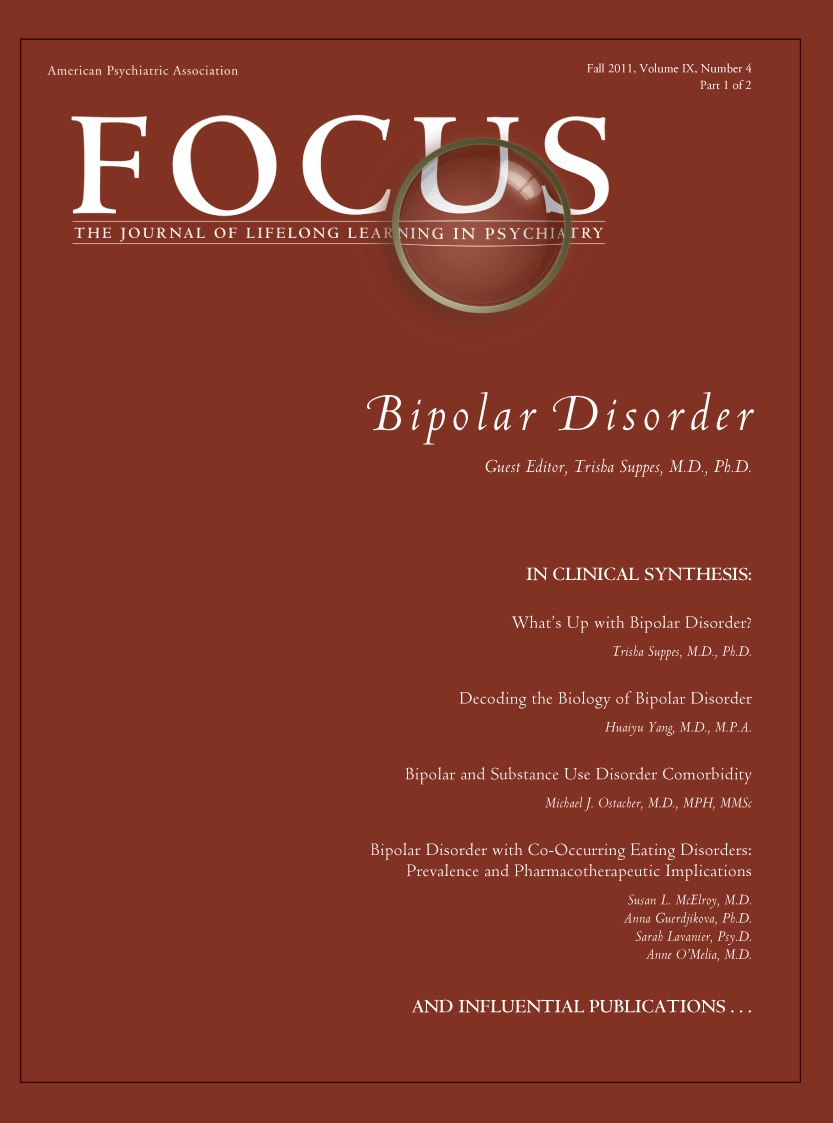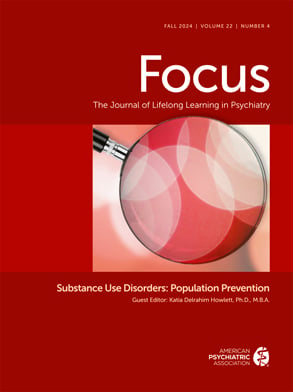Comparative Efficacy and Acceptability of Antimanic Drugs in Acute Mania: A Multiple-treatments Meta-analysis
Cipriani A, Barbui C, Salanti G, Rendell J, Brown R, Stockton S, Purgato M, Spineli LM, Goodwin GM, Geddes JR
Lancet. 2011 Oct 8;378(9799):1306–15
Background: Conventional meta-analyses have shown inconsistent results for efficacy of pharmacological treatments for acute mania. We did a multiple-treatments meta-analysis, which accounted for both direct and indirect comparisons, to assess the effects of all antimanic drugs. Methods: We systematically reviewed 68 randomised controlled trials (16,073 participants) from Jan 1, 1980, to Nov 25, 2010, which compared any of the following pharmacological drugs at therapeutic dose range for the treatment of acute mania in adults: aripiprazole, asenapine, carbamazepine, valproate, gabapentin, haloperidol, lamotrigine, lithium, olanzapine, quetiapine, risperidone, topiramate, and ziprasidone. The main outcomes were the mean change on mania rating scales and the number of patients who dropped out of the allocated treatment at 3 weeks. Analysis was done by intention to treat. Findings: Haloperidol (standardised mean difference [SMD] −0.56 [95% CI −0.69 to −0.43]), risperidone (− 0.50 [−0.63 to −0.38]), olanzapine (−0.43 [−0.54 to −0.32]), lithium (−0.37 [−0.63 to −0.11]), quetiapine (−0.37 [−0.51 to −0.23]), aripiprazole (−0.37 [−0.51 to −0.23]), carbamazepine (−0.36 [−0.60 to − 0.11]), asenapine (−0.30 [−0.53 to −0.07]), valproate (−0.20 [−0.37 to −0.04]), and ziprasidone (− 0.20 [−0.37 to −0.03]) were significantly more effective than placebo, whereas gabapentin, lamotrigine, and topiramate were not. Haloperidol had the highest number of significant differences and was significantly more effective than lithium (SMD −0.19 [95% CI −0.36 to − 0.01]), quetiapine (−0.19 [−0.37 to 0.01]), aripiprazole (−0.19 [−0.36 to −0.02]), carbamazepine (−0.20 [−0.36 to −0.01]), asenapine (−0.26 [−0.52 to 0.01]), valproate (−0.36 [−0.56 to −0.15]), ziprasidone (−0.36 [−0.56 to −0.15]), lamotrigine (−0.48 [−0.77 to −0.19]), topiramate (−0.63 [−0.84 to −0.43]), and gabapentin (−0.88 [−1.40 to −0.36]). Risperidone and olanzapine had a very similar profile of comparative efficacy, being more effective than valproate, ziprasidone, lamotrigine, topiramate, and gabapentin. Olanzapine, risperidone, and quetiapine led to significantly fewer discontinuations than did lithium, lamotrigine, placebo, topiramate, and gabapentin. Interpretation: Overall, antipsychotic drugs were significantly more effective than mood stabilisers. Risperidone, olanzapine, and haloperidol should be considered as among the best of the available options for the treatment of manic episodes. These results should be considered in the development of clinical practice guidelines.
Subthreshold Hypomanic Symptoms in Progression from Unipolar Major Depression to Bipolar Disorder
Fiedorowicz JG, Endicott J, Leon AC, Solomon DA, Keller MB, Coryell WH
Am J Psychiatry. 2011 Jan;168(1):40–8
Objective: The authors assessed whether subthreshold hypomanic symptoms in patients with major depression predicted new-onset mania or hypomania. Method: The authors identified 550 individuals followed for at least 1 year in the National Institute of Mental Health Collaborative Depression Study with a diagnosis of major depression at intake. All participants were screened at baseline for five manic symptoms: elevated mood, decreased need for sleep, unusually high energy, increased goal-directed activity, and grandiosity. Participants were followed prospectively for a mean of 17.5 years and up to 31 years. The Longitudinal Interval Follow-up Examination was used to monitor course of illness and to identify any hypomania or mania. The association of subthreshold hypomanic symptoms at baseline with subsequent hypomania or mania was determined in survival analyses using Cox proportional hazards regression. Results: With a cumulative probability of one in four on survival analysis, 19.6% (N = 108) of the sample experienced hypomania or mania, resulting in revision of diagnoses for 12.2% to bipolar II disorder and 7.5% to bipolar I disorder. Number of subthreshold hypomanic symptoms, presence of psychosis, and age at illness onset predicted progression to bipolar disorder. Decreased need for sleep, unusually high energy, and increased goal-directed activity were specifically implicated. Conclusions: Symptoms of hypomania, even when of low intensity, were frequently associated with subsequent progression to bipolar disorder, although the majority of patients who converted did not have any symptoms of hypomania at baseline. These results suggest that continued monitoring for the possibility of progression to bipolar disorder is necessary over the long-term course of major depressive disorder.
Transition to Mania During Treatment of Bipolar Depression
Perlis RH, Ostacher MJ, Goldberg JF, Miklowitz DJ, Friedman E, Calabrese J, Thase ME, Sachs GS
Neuropsychopharmacology. 2010 Dec;35(13):2545–52
Some individuals with bipolar disorder transition directly from major depressive episodes to manic, hypomanic, or mixed states during treatment, even in the absence of antidepressant treatment. Prevalence and risk factors associated with such transitions in clinical populations are not well established, and were examined in the Systematic Treatment Enhancement Program for Bipolar Disorder study, a longitudinal cohort study. Survival analysis was used to examine time to transition to mania, hypomania, or mixed state among 2166 bipolar I and II individuals in a major depressive episode. Cox regression was used to examine baseline clinical and sociodemographic features associated with hazard for such a direct transition. These features were also examined for interactive effects with antidepressant treatment. In total, 461/2166 subjects in a major depressive episode (21.3%) transitioned to a manic/hypomanic or mixed state before remission, including 289/1475 (19.6%) of those treated with antidepressants during the episode. Among the clinical features associated with greatest transition hazard were greater number of past depressive episodes, recent or lifetime rapid cycling, alcohol use disorder, previous suicide attempt, and history of switch while treated with antidepressants. Greater manic symptom severity was also associated with risk for manic transition among both antidepressant-treated and antidepressant-untreated individuals. Three features, history of suicide attempt, younger onset age, and bipolar subtype, exhibited differential effects between individuals treated with antidepressants and those who were not. These results indicate that certain clinical features may be associated with greater risk of transition from depression to manic or mixed states, but the majority of them are not specific to antidepressant-treated patients.
Cross-disorder Genomewide Analysis of Schizophrenia, Bipolar Disorder, and Depression
Huang J, Perlis RH, Lee PH, Rush AJ, Fava M, Sachs GS, Lieberman J, Hamilton SP, Sullivan P, Sklar P, Purcell S, Smoller JW
Am J Psychiatry. 2010 Oct;167(10):1254–63
Objective: Family and twin studies indicate substantial overlap of genetic influences on psychotic and mood disorders. Linkage and candidate gene studies have also suggested overlap across schizophrenia, bipolar disorder, and major depressive disorder. The purpose of this study was to apply genomewide association study (GWAS) analysis to address the specificity of genetic effects on these disorders. Method: The authors combined GWAS data from three large effectiveness studies of schizophrenia (CATIE, genotyped: N = 741), bipolar disorder (STEP-BD, geno-typed: N = 1,575), and major depressive disorder (STAR*D, genotyped: N = 1,938) as well as from psychiatrically screened control subjects (NIMH-Genetics Repository: N = 1,204). A two-stage analytic procedure involving an omnibus test of allele frequency differences among case and control groups was applied, followed by a model selection step to identify the best-fitting model of allelic effects across disorders. Results: The strongest result was seen for a single nucleotide polymorphism near the adrenomedullin (ADM) gene (rs6484218), with the best-fitting model indicating that the effect was specific to bipolar II disorder. Findings also revealed evidence suggesting that several genes may have effects that transcend clinical diagnostic boundaries, including variants in NPAS3 that showed pleiotropic effects across schizophrenia, bipolar disorder, and major depressive disorder. Conclusions: This study provides the first genomewide significant evidence implicating variants near the ADM gene on chromosome 11p15 in psychopathology, with effects that appear to be specific to bipolar II disorder. Although genomewide significant evidence of cross-disorder effects was not detected, the results provide evidence that there are both pleiotropic and disorder-specific effects on major mental illness and illustrate an approach to dissecting the genetic basis of mood and psychotic disorders that can inform future large-scale cross-disorder GWAS analyses.
Pharmacological Interventions for the Prevention of Relapse in Bipolar Disorder: A Systematic Review of Controlled Trials
Beynon S, Soares-Weiser K, Woolacott N, Duffy S, Geddes JR
J Psychopharmacol. 2009 Jul;23(5):574–91
We conducted a systematic review and meta-analysis of randomised and quasi-randomised controlled trials evaluating all clinically relevant pharmacological interventions for the prevention of relapse in people with bipolar disorder. Thirty-four trials were included in the review. Direct comparisons with placebo and with lithium were available for most drugs. In addition, there were direct comparisons of valproate vs. olanzapine, imipramine vs. lithium plus imipramine, olanzapine plus mood stabilisers vs. mood stabilisers and perphenazine plus mood stabilisers vs. mood stabilisers. Methodological quality varied across studies and the strength of evidence was not equal for all treatments or for all comparisons. There is evidence from placebo-controlled trials for the efficacy of lithium, valproate and lamotrigine as maintenance therapy for the prevention of relapse in bipolar disorder. Three drugs have a significant effect in the prevention of manic relapses (lithium, olanzapine and aripiprazole) and three in the prevention of depressive symptoms (valproate, lamotrigine and imipramine). Imipramine is little used in practice, because of concern about adverse effects. The significant effects of olanzapine and aripiprazole were demonstrated in selected responsive bipolar I patients only. Despite widespread use in clinical practice, there is little evidence to support the efficacy of combination therapy.

